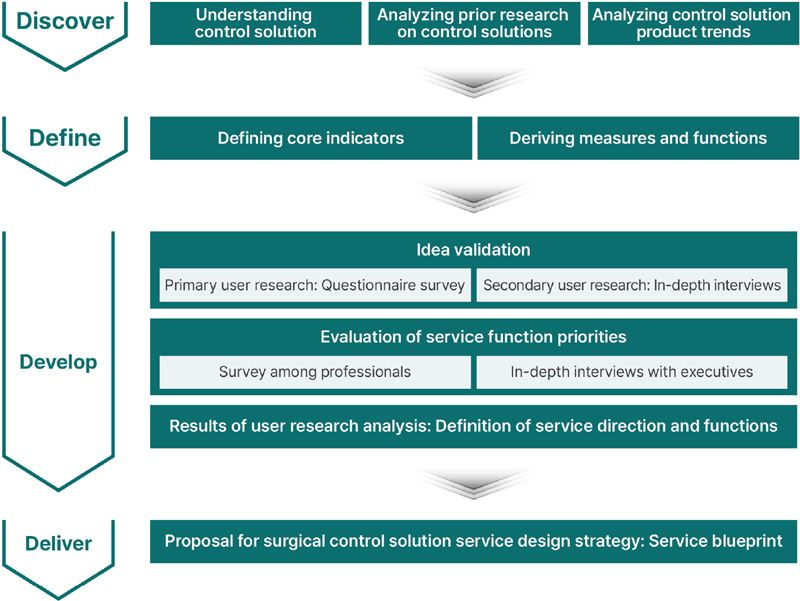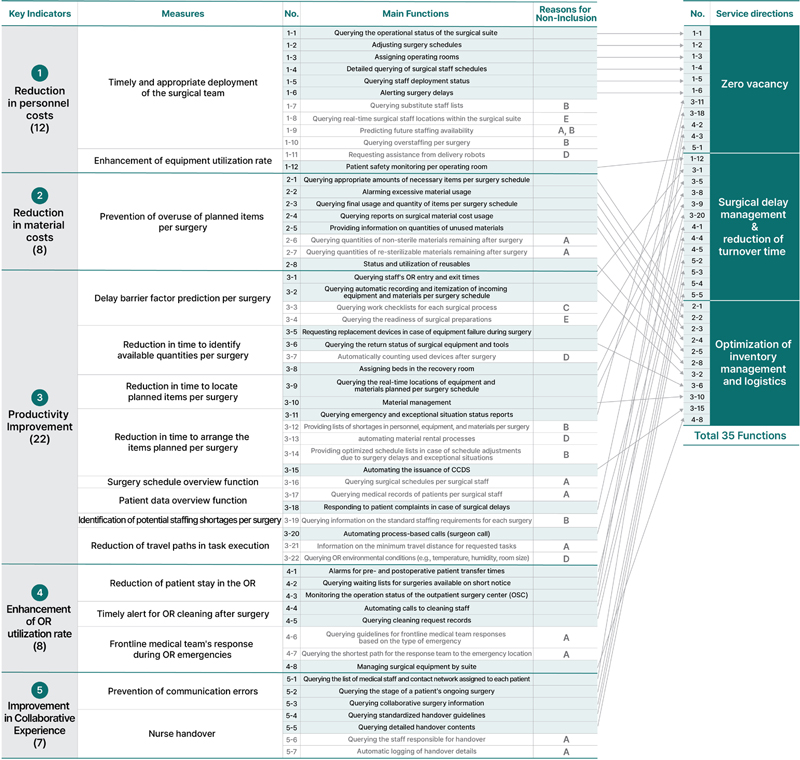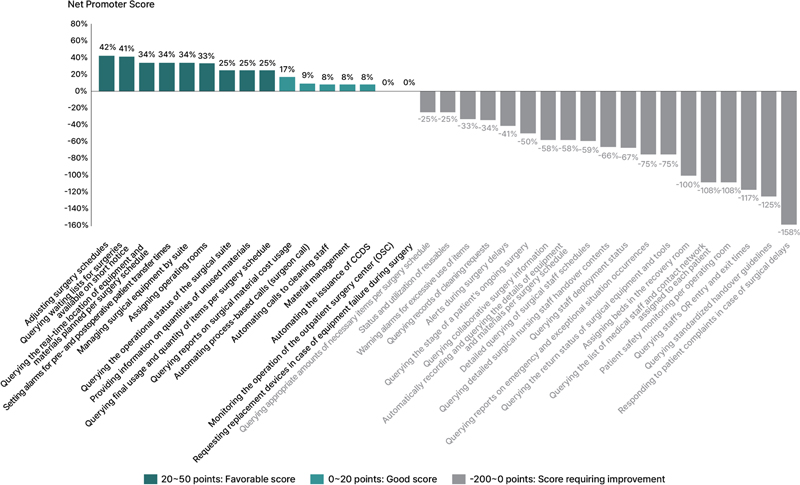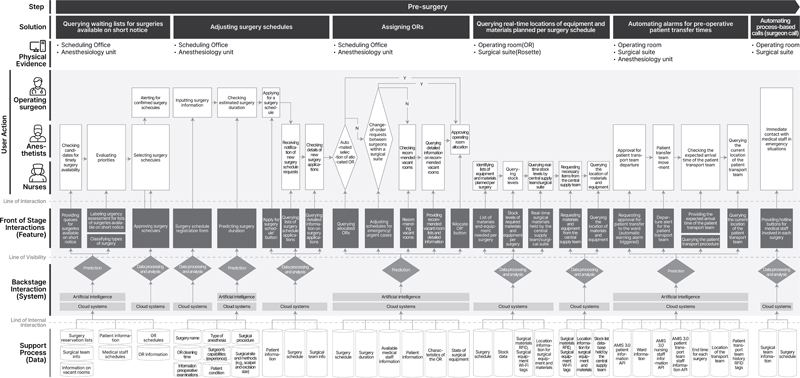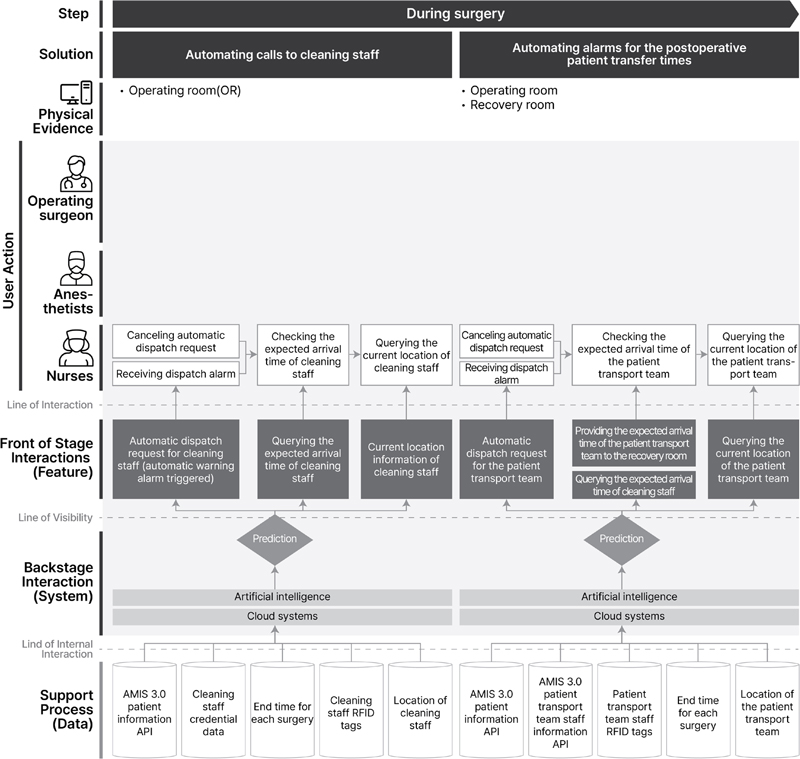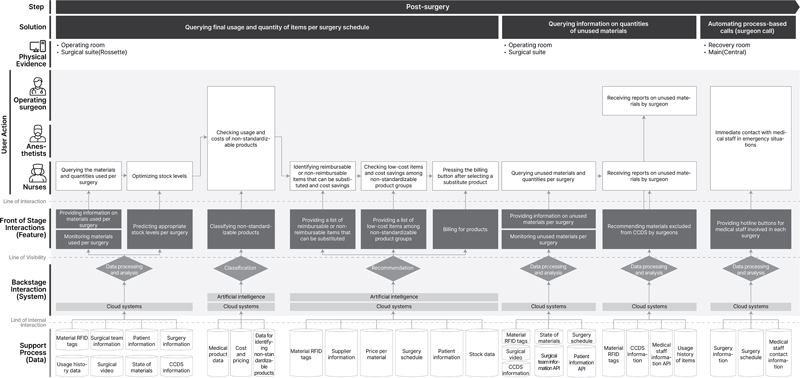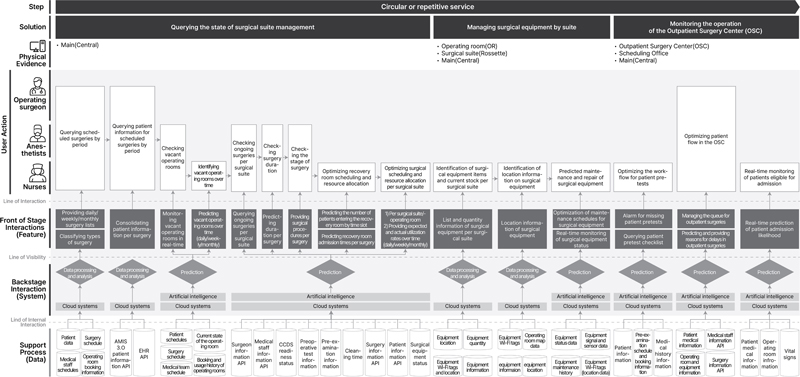
Control Solution Service Design and Strategy for Surgery: Focusing on a Service Blueprint
Abstract
Background Recently, as part of a global initiative to transform hospitals into smart facilities, control solution services have been increasingly adopted to streamline hospital operations. In South Korea, a market gap exists for products fulfilling healthcare professionals/specific healthcare settings’ direct needs. Thus, we propose a control solution service design tailored to the environmental and operational requirements of healthcare professionals in tertiary South Korean hospitals, recognizing their urgent need for smart hospital infrastructure. Specifically, considering the expectation for tertiary general hospitals within the national healthcare system to perform highly sophisticated surgeries, we introduce a surgical control solution service design model with relevant strategies.
Methods We utilized the Double Diamond—a user-centered service design methodology. Initially, we defined the control solution concept through an extensive literature review and analyzed market and product trends. After gathering data, we identified core indicators using an affinity diagram. Subsequently, we detailed specific measures and functions for each indicator in a co-creation workshop. Further, we evaluated the validity of the derived indicators, measures, and functions and prioritized them in hospital management. To this end, we conducted a qualitative investigation—a user research (three steps with 12 healthcare providers and one with three management executives).
Results The user research identified three key service directions—zero vacancy, surgical delay management and reduction of turnover time, and optimization of inventory management and logistics—along with 35 functions. Following priority evaluation, 12 main functions were selected: adjusting surgery schedules; querying waiting lists for surgeries available on short notice; assigning operating rooms (ORs); querying the state of surgical suite management; monitoring the operation of the Outpatient Surgery Center; querying real-time locations of equipment and materials planned per surgery schedule; automating alarms for preoperative and postoperative patient transfer times; automating process-based calls (surgeon call); automating calls to cleaning staff; managing surgical equipment by suite; querying final usage and quantity of items per surgery schedule; and querying information on quantities of unused materials. Based on these functions, we developed a service model and strategies centered around a service blueprint.
Conclusions We used the Double Diamond to determine the surgery control solution’s service directions and functions. Unlike previous technology-centered products, this approach focuses on user characteristics and environmental factors, making it ideal for tertiary general hospitals. The solution aims to improve healthcare workers’ intention for sustained use and is anticipated to aid OR tasks and ameliorate management outcomes.
Keywords:
Service Design, Design Strategy, Design Management, Smart Hospital, Surgical Control Solution, Command Center1. Introduction
1. 1. Research background and purpose
Advancements in Information and Communications Technology (ICT) have driven the recent acceleration toward smart hospitals. These facilities utilize innovative technologies to connect digitally with different ecosystems, improving patient-centered service quality and experiences while lowering medical costs (Chen et al., 2019). In South Korea, Bundang Seoul National University Hospital developed an integrated control solution to monitor remote Intensive Care Units (ICUs) and establish a cooperative healthcare system with the ICU control center and partner healthcare facilities. Ewha Womans University Seoul Hospital has introduced an integrated clinical command center to monitor the vital signs of critically ill patients and enable immediate emergency responses (Lee, 2020). Keimyung University Dongsan Medical Center has introduced an autonomous robot with a biometric authorization system and a fast drug delivery system. This robot tracks the real-time location and status of surgical instruments, helping to manage hospital resources efficiently (Kim, 2021). Internationally renowned medical centers such as Johns Hopkins Hospital, Tampa General Hospital, and Humber River Hospital have implemented control solutions. For instance, Johns Hopkins Hospital has improved its management performance, with a 60% increase in patient capacity from other areas, a 30% decrease in emergency room bed assignment times, and a 70% reduction in surgical transfer delays (Lee, 2020). The global trend toward smart hospitals is expected to improve medical services’ efficiency and effectiveness by optimizing hospital operations.
However, the integration of new technologies in hospital environments presents challenges, including difficulties in recruiting specialized personnel and the labor and maintenance costs associated with these systems (Park, 2021). Further, despite the advancement of new technologies in innovative systems, ongoing conflicts during the adoption process can negatively affect willingness to continue using them. This underscores the importance of adopting a user-centric approach (Yang & Shin, 2010). Moreover, an analysis of control solution implementations in hospitals—in Korea and globally—illustrates the prevalence of a technology-driven approach. This method heavily depends on the five key technologies of the Fourth Industrial Revolution (IoT, Cloud Computing, Big Data, Mobile, and AI) from the supplier’s perspective. It highlights a lack of research from a user-focused design perspective that considers the real medical setting, as well as the experiential needs and satisfaction of medical personnel—currently, these viewpoints are not adequately represented.
Therefore, this study proposes a control solution design model based on the service design method that prioritizes a user-oriented approach, going beyond the limitations of the conventional technology-oriented approach. Specifically, this study revisits the value and role of the control solution that can enhance healthcare providers’ intention for sustained use and design functions that reflect the characteristics of healthcare providers and medical environments in South Korea, allowing for the effective introduction of the model to Korean hospitals.
This study primarily focuses on its relevance to tertiary general hospitals looking to upgrade their smart hospital infrastructure, especially in their surgical suites. This emphasis is justified by the pivotal role these hospitals play in addressing high-severity diseases and conducting highly sophisticated surgeries (Hwang et al., 2016). McKinsey & Company’s prediction states that surgical suites will become a domain exclusive to tertiary general hospitals (Chen et al., 2019). Focusing on patient-centered care, this study develops a service design model and strategy for surgical control solutions tailored specifically for surgical suites. By understanding the environmental context, the goal is to create a user-centric approach.
1. 2. Research method
This study used the Double Diamond process by the UK Design Council to design a user-oriented surgical control solution service. However, as the number of control solution cases specialized in operating rooms (ORs) is insufficient, the previous Double Diamond process was modified and applied to define the specific role and purpose of surgical control solutions and harmoniously reflect the complexity of hospital environments and the needs of various stakeholders.
During the “discover” step, a literature review was conducted to discuss the concept and role of surgical control solutions. The meaning and role of control solutions in hospitals were examined by analyzing previous studies and product trends, while functions relevant to ORs were explored.
In the “define” step, the functions of control solutions explored in the “discover” step were categorized using the affinity diagram, while core indicators regarding ORs were derived. Subsequently, specific measures and items for each core indicator were concretized through a co-creation workshop.
In the “develop” step, user research was conducted to select core functions for increasing the users’ intention of sustained use and the efficiency of hospital operations. First, idea verification was conducted with working-level employees, followed by a priority evaluation with working-level employees and management executives, obtaining 12 core functions.
In the “deliver” step, the 12 derived core functions were visualized through a service blueprint, based on which a design strategy for surgical control solutions was proposed. During this process, tangible and intangible elements were identified for solution implementation, and activities were classified into preoperative, intraoperative, postoperative, circular or repetitive service steps to visualize how the users experience each function. The details of the research method are as follows [Figure 1].
2. Discover
2. 1. Understanding control solution
While there is no universally agreed-upon definition of “control solution” in hospitals, a study describes it as a set of physical and cross-functional units, including the use of real-time data (e.g., electronic medical records) and managing patient flow processes, such as admission services, bed management, interhospital transfers, and environmental services (Franklin et al., 2022). KLAS research analyzed Operational Command Centers from seven different vendors and the hospitals that implemented these systems. They concluded that adopting hospital command systems has consistently benefited hospital management and financial performance despite variations in functions and outcomes (Egbert & Paxman, 2018). For example, GE Healthcare’s Capacity Command Center utilizes advanced technologies such as predictive analytics, AI, and natural language processing to reduce patient stays and digitalize patient experiences. This enhances healthcare system efficiency and satisfaction for healthcare workers and patients (Korea Health Industry Development Institute (KHIDI), 2021). TeleTracking has reported increased profits by improving OR utilization and reducing inpatient stays (Egbert & Paxman, 2018). At the Radiology Society of North America in 2022, Philips Healthcare unveiled a Radiology Operations Command Center. This center allows for remote management of radiology equipment in the main hospital and its subsidiary hospitals—a breakthrough in integrating AI-based technology to enhance radiological diagnoses, informatics, and workflows (Kim, 2022). The examples show that the conceptual definitions of hospital control solutions can vary based on their functions. The current implementations in hospitals are outlined in Table 1.
2. 2. Analyzing prior research on control solutions
The research trend concerning control solutions in hospitals was investigated by conducting a literature search in academic bibliographic databases such as Google Scholar, Web of Science, and PubMed (as of July 2023). The search terms were hospital command center, design, OR, service design, and user experience. The scope of the literature review was limited to papers that included “hospital command center” and “design.” After excluding studies not directly related to the keywords or duplicates, 190 papers were selected.
After examining the title and abstract of the selected papers, conducted a systemic review of the Capacity Command Center. During this process, studies on the conceptual characteristics of control solution and performance improvement results were compared and categorized into “concept,” “method/process improvement,” and “effectiveness” according to Franklin et al.’s (2022) classification system and standardization. Based on these criteria, 181 papers were excluded, with 11 papers—the remaining nine and two additional design papers highly relevant to this study—selected for analysis.
The main findings from the selected studies are outlined in Table 2. Prior research analysis found that studies on control solutions mostly focus on defining indicators to prioritize the concept and functions of solutions such as CCC, Mission Control Center, and Hospital Incident Center (Collins, 2021; Lee et al., 2019; Martinez et al., 2018). Methods for process improvement (Alhaider et al., 2020; Dicuonzo et al., 2023; Kayış et al., 2022) and research on the effects of implementing control solutions (Franklin et al., 2023; Krennerich et al., 2022; Park et al., 2020) were also highlighted. Few studies have addressed design aspects, such as OR space design (Sabnis et al., 2013) and the efficiency of the Surgical Safety Checklist template design (Lorkowski & Maciejowska-Wilcock, 2021). Furthermore, studies from a service design perspective that address healthcare workers’ pain points and needs are lacking.
2. 3. Analyzing control solution product trends
According to global healthcare IT market research firm KLAS Research, control solutions comprise eight areas: data analysis, communication, location tracking, case/management, telehealth, scheduling, revenue cycle, and asset inventory management. Among these, hospitals are most interested in data analysis, communication, location tracking, and telehealth, where different vendors offer varying business approaches and services (Oscarson & Paxman, 2021). Major control solution vendors include Care Logistics, Central Logic, TeleTracking, Cerner, Epic, Philips, and GE Healthcare. The former three offer software-based control solutions for patient flow and transfers. Cerner and Epic provide systems integrated into hospitals’ Electronic Medical Records, while Philips specializes in control solutions for radiology. Notably, GE Healthcare was ranked highest in Vision Innovation, Performance, and Customer Impact compared to its competitors (Lindsey, 2021). GE Healthcare offers a capacity optimization software-based control service that uses AI technology from the Edison Intelligence Platform and real-time information analysis. In South Korea, Ewha Womans University Seoul Hospital was the first in Asia to partner with GE Healthcare to introduce a control solution. They have implemented it in their Clinical Command Center to monitor the vital signs of ICU patients and promptly respond to emergencies (Lee, 2019).
A case study on control solutions from various vendors identified 51 OR-related functions. Globally, implementing control solutions in hospitals has significantly improved management efficiency and user satisfaction. Nevertheless, in South Korea, despite efforts to implement these solutions in large tertiary hospitals, which often face treatment delays and bottlenecks due to limited capacity, it is challenging to find cases where these implementations have considerably increased users’ intention to continue use. This may be due to a service design that prioritizes the provider’s perspective rather than the needs of healthcare workers, who are the actual users of the service.
3. Define
3. 1. Defining core indicators
To define the role of surgical control solution services and identify key indicators, the functions of control solutions discussed in Section 2.3 were categorized using an Affinity Diagram, yielding five core indicators: reduction in personnel costs, reduction in material costs, productivity improvement, enhancement of OR utilization rate, and improvement in collaborative experience. The functions and related indicators are shown in Figure 2.
Reduction in personnel costs is possible through personnel allocation and operation optimization, contributing to reducing overall costs. Reduction in material costs entails the use of a proper amount of material for operation, decreasing resource waste and increasing hospital management’s cost efficiency. Productivity improvement removes the bottleneck phenomenon and secures time for healthcare providers to focus on patient treatment through automation and procedure improvement. Enhancing the OR utilization rate optimizes the use of OR to reduce downtime and increase profitability. Improving collaborative experiences facilitates collaboration between departments through efficient information sharing and communication. The five core indicators derived from the affinity diagram suggest how surgical control solutions specifically contribute to hospital operations. Most importantly, higher productivity and utilization rate significantly impact physical elements (e.g., equipment maintenance) and managerial elements (e.g., personnel and information management)—various surgical-procedure-related tasks can be optimized. Therefore, surgical control solutions can maximize the efficiency of the overall hospital operation and provide patients with quality healthcare service, going beyond merely a tool for reducing costs.
3. 2. Deriving measures and functions
Based on the five core indicators, desk research and co-creation workshops were conducted to determine detailed measures and functions customized for the operational room management system and work environments of tertiary general hospitals. The measures were gathered from domestic reports and studies related to indicators such as enhancing OR utilization rates, maximizing OR equipment use, and implementing cost-saving activities from 2010 to 2022. The functions were identified during the co-creation workshop on April 9, 2023, facilitated by three service designers and researchers proficient in operational command systems and work environments of tertiary general hospitals. They used the How Might We methodology. The workshop primarily focused on answering the question, “Who should we provide which function to improve this measure?” Consequently, five core indicators, 17 measures, and 48 functions were pinpointed, as outlined in Table 3.
The specific measures and functions in [Table 3] provide specific ways to realize each core indicator. Regarding the reduction in personnel costs, necessary personnel can be deployed in the right place at the right time through functions such as future staffing availability prediction and real-time surgical staff location query. In the case of surgery delay or cancellation, prompt deployment of alternative personnel increases operation efficiency. Additionally, increased utilization of automated equipment (e.g., robots) creates an environment that reduces the burden of personnel management.
To reduce material costs, a proper amount of material is used through functions such as predicting the proper amount of necessary material for each surgery and querying the amount of unused material. Moreover, systematic management of unused material increases the efficiency of resource utilization and strengthens the transparency of material management in ORs.
In terms of productivity improvement, automation functions related to surgery preparation and procedure are provided to reduce the time needed to check the availability and location of materials and equipment in ORs and, in real time, the status of surgery preparation and task checklist per process. Furthermore, structured management system predicts surgery delay factors and provides notifications to help healthcare providers deal with problems without incurring human errors. These functions enable healthcare providers to focus on surgical tasks more efficiently.
Higher OR utilization rate helps accurately predict preoperative and postoperative patient transfer times to reduce patients’ OR stay, while automated calls to cleaning staff after surgery minimize surgery delays and maximize the utilization rate during regular work hours.
Finally, improvement in collaborative experience ensures smooth information sharing and prevents communication errors between departments while enhancing, in real time, collaboration and teamwork between healthcare providers.
4. Develop
Based on the literature review results from the “discovery” step, in the “define” step, five core indicators of surgical control solution were derived, and 17 specific measures and 48 functions were derived from the co-creation workshop.
In the “develop” step, to enhance the users’ intention for sustained use and improve the efficiency of hospital operations, four-step user research was designed as a comprehensive empirical investigation based on the five core indicators, 17 specific measures, and 48 functions. First, idea verification was conducted with working-level employees to examine whether the 48 functions would be effective when implemented as specific solutions. This process comprised two steps. In the primary user research, a questionnaire was employed to collect user opinions; in the secondary user research, in-depth interviews were conducted to gather and analyze specific opinions. Subsequently, by reflecting Korean hospitals’ operation organization approach and OR management rules, a priority evaluation was conducted to identify core functions that must be applied promptly in practice. This process also comprised two steps. In the primary user research, a questionnaire was used for working-level employees; in the secondary user research, in-depth interviews were conducted with hospital executives. Thus, 12 core functions were selected.
4. 1. Idea verification
We aimed to determine the direction of the surgical control solution service and its key functions by assessing the core indicators, measures, and functions from the user’s perspective. Accordingly, we undertook a questionnaire survey and in-depth interviews with 12 participants from April 20 to June 1, 2023. These participants included six surgical nurses and six specialists, all with at least two years of surgical experience and currently working at Seoul Asan Medical Center—a top tertiary general hospital in Seoul. Participant profiles can be found in Table 4.
The initial user survey was conducted by utilizing a closed questionnaire to test the hypothesis that the 48 functions (as explained in Section 3.2) impacted the core indicators. Participants were briefed on the study objectives and content via email from April 20 to 28, 2023. They were asked to confirm their intent to participate and, upon providing consent, complete a self-report questionnaire. The questionnaire comprised 54 items divided into two domains: six items rated on a 7-point Likert scale to assess the importance of each core indicator and 48 binary (yes/no) items to evaluate the suitability of each function. The structure of this closed questionnaire is illustrated in Figure 3.
The secondary user research uncovered hidden needs and pain points of respondents through open-ended interviews. This approach was especially useful in cases where desired functions were omitted or did not align with actual user requirements in the closed questionnaire. The interviews were conducted from April 25 to June 1, 2023, by three control service designers and researchers who acted as interviewers. Prior consent was obtained for voice recording to ensure ethical data collection. The interview content was based on participants’ responses to the previous closed questionnaire and a semi-structured open questionnaire. Free conversations helped identify keywords. Each interview lasted around 60 minutes (range: 40–90 minutes). Participants were encouraged to share their thoughts and experiences in detail.
Initially, the evaluation revealed that surgical nurses prioritize productivity improvement, while medical specialists emphasize the enhancement of the OR utilization rate. Subsequently, the validity assessment of the 48 functions related to the core indicators, as included in the closed questionnaire, led to the incorporation of nine additional functions derived from open-ended interviews, ultimately yielding 57 functions. Open-ended interviews used text mining analysis to identify frequently mentioned keywords not present in the closed questionnaire, considering them hidden needs. The criteria outlined in Table 5 were used to evaluate whether the functions are aptly reflected in their respective core indicators.
Using these five evaluation criteria, 35 functions were selected from 57 across five core indicators: reduction in personnel costs (n=7), reduction in material costs (n=6), productivity improvement (n=11), enhancement of OR utilization (n=6), and improvement in collaborative experience (n=5). Reasons for not reflecting functions were as follows: ten cases of A (poor improvement in core indicator), six cases of B (technological restraints), four cases of D (cost restraints), two cases of E (low frequency), one case of C (possibility of replacing the previous system. By applying thematic analysis to the selected functions, three service directions were defined, as shown in [Figure 4].
According to the usage context and purpose, the 35 functions were clustered based on similar characteristics and analyzed. Consequently, three service direction categories were derived: 1) zero vacancy, 2) surgery delay management and reduction of turnover time, and 3) optimization of inventory management and logistics. “Zero vacancy” comprises 11 functions for minimizing OR downtime. “Surgery delay management and reduction of turnover time” comprises 13 functions for reducing the transition time between surgeries and prevent surgery delays. “Optimization of inventory management and logistics” comprises 11 functions for optimizing resource usage and improving the financial indicators of ORs. The 35 functions derived from this process are vital in implementing OR operation optimization solutions by effectively managing and improving the five core indicators.
4. 2. Evaluation of service function priorities
The service function priorities were assessed through a survey conducted with 12 professionals who participated in user research using SurveyMonkey from November 13 to 24, 2023. The questionnaire comprised 71 items across two parts: evaluating the importance of service directions (1 item) and prioritizing functions (70 items). The first questionnaire item, the importance evaluation of service directions, was designed in a way whereby weights were applied for adjustments when ambiguous results were obtained from the function priority evaluation. The importance of each service direction was evaluated using the weighted method and converted into a score out of 100 for quantitative comparison. Thus, the importance of service directions was differentiated according to service strategy goals, deriving more accurate decisions.
Using the Eisenhower Matrix, the second item—the function priority evaluation— examined “contribution,” which suggests the impact of each function on service directions, and “urgency,” which indicates the necessity of introducing each function in practice. Contribution and urgency were measured using the Net Promoter Score (NPS)—a useful tool for measuring customer satisfaction. In NPS, customers are classified into Promoters (9–10 points), Passives (7–8 points), and Detractors (0–6 points), while the group of passives is excluded from the calculation, making it possible to focus on the highly loyal and highly discontent groups. This point contributes to prioritizing functions that will affect user satisfaction the most when selecting the final functions.
The evaluation of service directions importance yielded 40 points for “zero vacancy,” while “optimization of inventory management and logistics” and “surgical delay management and reduction of turnover time” each scored 30 points. Despite “zero vacancy” receiving the highest score, the variations in scores were not sufficiently significant statistically to impact the overall evaluation. The composite NPS for the function priority evaluation is shown in Figure 5.
From July 31 to August 11, 2023, in-depth interviews were conducted with three executives to validate the usefulness and appeal of the proposed service directions and functions. The executives were provided with detailed explanations of the service directions and functions, and evaluations were undertaken using Concept Value Testing (Kim & Kim, 2020; Pascal, 2023). This method focused on assessing service appeal, service direction priorities, and design requirements. The service appeal, rated on a 5-point Likert scale, received a top rating of 5 from all respondents. Additionally, the executives identified “surgical delay management and reduction of turnover time” as the most important service direction. The interviews showed that, despite the high service appeal, the implementation of functions would need to be phased due to resource constraints.
4. 3. Definition of functions
A thorough analysis based on two criteria resulted in the selection of features for the proposed surgical control solution service, as outlined in Table 6. Initially, functions with an NPS result higher than 20% were considered excellent, with nine functions meeting this requirement. Moreover, three more functions scoring “0% and above,” in line with the hospital’s management efficiency policies, were selected. This yielded 12 final functions chosen for implementation.
5. Deliver
5. 1. Proposal for surgical control solution service design strategy: Service blueprint
This section proposes a service blueprint that visualizes the 12 key functions of surgical control solution according to the OR environment and usage context [Figure 6-A, Figure 6-B, Figure 6-C, Figure 6-D]. The service blueprint, proposed by Lynn Shostack (1982), is a tool employed to design a user-oriented service model and visualize the tangible and intangible elements and process of user service experience (Fließ & Kleinaltenkamp, 2004).
The surgical control solution comprises the following components: Step, Solution, User Action, Front of Stage Interaction, Backstage Interaction, and Support Process. Step indicates service journey and is classified into four activities: pre-surgery, during surgery, post-surgery, and circular or repetitive activities. Solution refers to the 12 key functions derived from the user research and is matched with each step according to the usage context. Based on the interactive visibility line, there are front and back stages. In the Front Stage, the experience of the main users—surgeon, anesthesiologist, and nurse—were expressed through physical evidence related to OR environments such as schedule office, recovery room, and anesthesiology unit. Users’ actions taken while using the 12 functions were expressed as User Action, and the functions that users actually interact with were concretized into Front of Stage Interaction. Meanwhile, essential systems for service provision that users do not directly encounter were expressed as Backstage Interaction.
Data for implementing specific functions of service were classified into Support Process. To respond effectively to various non-linear scenarios in hospital environments, such as unexpected changes in surgery schedule and emergency surgery, a solution based on AI technology and a cloud-based data mart was designed. Through real-time data analysis, this system endows healthcare providers with appropriate information to help them respond to changes in surgery schedule or emergencies. Therefore, hospitals can efficiently operate 73 ORs simultaneously.
( I ) Querying waiting lists for surgeries available on short notice
Based on data concerning patients, ORs, the surgical team, and surgery information collected from the cloud, the AI prediction model identifies surgery schedules on short notice, evaluates priorities, and provides a list. Subsequently, based on the information predicted and recommended by AI, the stakeholders for the confirmed surgery—anesthesiologist and nurse—formulate a surgery schedule. This enables the systematic management of non-linear processes in hospitals and strengthens the clear cooperation structure between roles. Additionally, vacancy rate can be minimized by flexibly responding to unexpected events.
( II ) Adjusting surgery schedules
When a surgeon inputs surgery information, estimated surgery duration is predicted, and an optimal surgery schedule is recommended. When a schedule is finally confirmed, it is automatically shared, in real time, with the surgical team, including anesthesiologists and nurses. This function helps with adjusting schedules in the context of non-linear hospital environments and making prompt decisions, reducing the vacancy rate and increasing the efficiency of OR operations.
( III ) Assigning ORs
This function of readjusting ORs analyzes surgery duration and resource availability by using surgical control data and recommends the optimal OR. If there is no available OR or emergency and ultra-emergency surgery is necessary, a request for an OR can be made. Subsequently, the anesthesiologist reviews the list of recommended ORs and related specific information before granting a final approval. This function reduces communication costs and human errors due to manual work while automating the complex resource adjustment process, increasing hospital operations’ efficiency.
( IV ) Querying real-time locations of equipment and materials planned per surgery schedule
This function queries real-time locations of equipment and materials planned per surgery schedule. Moreover, it is possible to check the real-time stock of the central supply team and submit an immediate request for insufficient materials. Through the AI monitoring system that automates the previous manual work process, equipment and materials are provided in time, and human errors in resource management are minimized, maximizing hospital operations’ efficiency.
( V ) Automating alarms for pre-operative patient transfer times
This function provides the optimal path based on the real-time location of the patient transfer team and prevents surgery delays by offering an estimated time for transfer completion from the unit to the OR. This addresses the bottleneck phenomenon in patient transfer and makes the transfer process smooth, preventing surgery delays.
( VI ) Automating process-based calls (surgeon call)
This function is used in the case of emergency during the pre-surgery step. The cloud-based system analyzes, in real time, information on the surgical team and data on the surgery schedule. A button is provided to make an emergency call to the surgical team per surgery, addressing the inefficiency of manual calls and reducing emergency response time.
( I ) Automating call to cleaning staff
This function makes an automated call to cleaning staff and provides an estimated time of arrival and current location. When the surgery is finished, a request for cleaning is submitted, minimizing cleaning preparation and turnover time. This function improves the inefficiency of manual calls and phone/in-person calls, reducing the workload of healthcare providers and addressing the surgery delay problem.
( II ) Automating alarms for postoperative patient transfer times
This function provides the optimal path based on the real-time location of the patient transfer team during transfer from the recovery room to the unit and predicts an estimated time of transfer completion. Patient flow within the recovery room can be efficiently managed, allowing for more effective utilization of space and resources.
( I ) Querying final usage and quantity of items per surgery schedule
This function tracks the quantity and cost of material used during surgery and supports inventory management. It is possible to query the amount of material used for surgery and provide a list of replaceable items and cost information. This function optimizes inventory, in real time, through AI and cloud-based systems and submits a request for additional material when necessary. This makes it possible to monitor the use of resources by healthcare providers transparently and save costs through efficient resource management.
( II ) Querying information on quantities of unused materials
This function monitors the final usage of material and unused material per surgery schedule and provides a report on unused material per surgeon, encouraging material saving behaviors. Thus, it is possible to manage unused material efficiently, maximizing the efficiency of hospital resource management.
( III ) Automating process-based calls (surgeon call)
This function is used for post-surgery emergencies, improving the previous call method whereby the list of surgeons and contact information are manually checked based on OR information and operation record. This system provides the surgery information, schedule, and contact information of the surgical team in an integrative manner and can make a call to medical staff per surgery. This function helps medical staff respond promptly and accurately to emergencies and prevents surgery delays.
( I ) Querying the state of surgical suite management
This function helps medical staff respond promptly to problems by sharing real-time information on surgery schedule per period, patient information per surgery, vacant OR monitoring, vacant OR prediction over time, surgery information in progress, surgery duration, surgery progress, and prediction of the hourly number of inpatients in the recovery room. Moreover, by predicting the accurate duration of surgery, it helps medical staff to manage their schedules more accurately, increasing the efficiency of managing the OR.
( II ) Managing surgical equipment by suite
This function manages the list, quantity, and location of surgical equipment in real time, and optimizes the maintenance schedule by predicting the state of equipment. The cloud-based system stores and tracks equipment information and analyzes the state of equipment using AI to predict the proper maintenance time-point to maximize the efficiency of equipment management. This function predicts the state of equipment to prevent any problems due to equipment failures and increase the efficiency of hospital resource management.
( III ) Monitoring the operation of the Outpatient Surgery Center (OSC)
This function monitors in real time and optimizes patient flows in the OSC. The system, based on AI and the cloud, smoothens the surgery procedure by managing pretest, waiting time, and the possibility of hospitalization, etc. to improve patient flow and efficiently secure available beds.
6. Conclusions
This study attempted to design a surgical control solution using a user-oriented service design approach with the aim of increasing users’ intention for sustained use and improving hospital business performance. Based on a literature review and user research analysis, three service directions were identified: zero vacancy, surgical delay management and reduction of turnover time, and optimization of inventory management and logistics. The study proposed a service strategy and model focused on a service blueprint, outlining 12 functions: 1. adjusting surgery schedules; 2. querying waiting lists for surgeries available on short notice; 3. assigning operating rooms; 4. querying the state of surgical suite management; 5. monitoring the operation of the OSC; 6. querying real-time locations of equipment and material planned per surgery schedule; 7. automating alarms for preoperative and postoperative patient transfer times; 8. automating process-based calls (surgeon call); 9. automating call to cleaning staff; 10. managing surgical equipment by suite; 11. querying final usage and quantity of items per surgery schedule; 12. querying information on quantities of unused materials.
The importance of this study is evident in three key aspects.
First, domestic and foreign market trends, product analysis, and related literature were meticulously reviewed to derive core indicators and measures based on which user research was conducted. This process ensured the objectivity and reliability of the study.
Second, by establishing the service directions and functions of surgical control solution based on user characteristics, usage context, and utilization context, this study is differentiated from technology-oriented previous studies. Specifically, a user-oriented service design approach was employed to conduct four rounds of user research with medical professionals and executives of tertiary hospitals, reflecting the actual needs of users.
Third, this is the first study in South Korea to propose functions that support the judgments and actions of the surgical team and introduce a surgical control solution service model. This model contributes to optimizing OR tasks and improving management performance.
This study has a few limitations. First, the research identified three service directions and 12 functions of the surgical control solution service through user research with healthcare professionals in South Korea’s tertiary hospitals. This restricts the generalizability of the findings to hospitals abroad or smaller institutions. Second, as the service blueprint scenarios, proposed as a step prior to solution implementation, were not verified, there are limitations in determining the effectiveness. Therefore, future research should test scenarios in actual environments and verify the effectiveness, increasing the validity of the findings.
Acknowledgments
This research was supported by a grant of the Korea Health Technology R&D Project through the Korea Health Industry Development Institute (KHIDI), funded by the Ministry of Health & Welfare, Republic of Korea (grant number : HR20C0026).
Notes
Copyright : This is an Open Access article distributed under the terms of the Creative Commons Attribution Non-Commercial License (http://creativecommons.org/licenses/by-nc/3.0/), which permits unrestricted educational and non-commercial use, provided the original work is properly cited.
References
-
Alhaider, A. A., Lau, N., Davenport, P. B., & Morris, M. K. (2020). Distributed situation awareness: A health-system approach to assessing and designing patient flow management. Ergonomics, 63(6), 682-709.
[https://doi.org/10.1080/00140139.2020.1755061]

- Chen, B., Baur, A., Stepniak, M., & Wang, J. (2019). Finding the future of care provision: The role of smart hospitals. McKinsey & Company. https://www.mckinsey.com/industries/healthcare/ourinsights/finding-the-future-of-care-provision-the-role-of-smart-hospitals#/.
-
Collins, B. E. (2021). Use of high-reliability principles in the evolution of a hospital command centre. Healthcare Quarterly (Toronto, Ont.), 23(4), 46-52.
[https://doi.org/10.12927/hcq.2020.26393]

-
Dicuonzo, G., Donofrio, F., Fusco, A., & Shini, M. (2023). Healthcare system: Moving forward with artificial intelligence. Technovation, 120, 102510.
[https://doi.org/10.1016/j.technovation.2022.102510]

- Egbert, T., & Paxman, E. (2018). Operational Command Centers 2018. KLAS Research. https://klasresearch.com/report/operational-command-centers-2018-an-underutilized-approach-to-improving-efficiency-and-outcomes/1281.
-
Fließ, S., & Kleinaltenkamp, M. (2004). Blueprinting the service company: Managing service processes efficiently. Journal of Business Research, 57(4), 392-404.
[https://doi.org/10.1016/S0148-2963(02)00273-4]

-
Franklin, B. J., Mueller, S. K., Bates, D. W., Gandhi, T. K., Morris, C. A., & Goralnick, E. (2022). Use of hospital capacity command centers to improve patient flow and safety: A scoping review. Journal of Patient Safety, 18(6), e912-e921.
[https://doi.org/10.1097/PTS.0000000000000976]

-
Franklin, B. J., Yenduri, R., Parekh, V. I., Fogerty, R. L., Scheulen, J. J., High, H., Handley, K., Crow, L., & Goralnick, E. (2023). Hospital capacity command centers: A benchmarking survey on an emerging mechanism to manage patient flow. The Joint Commission Journal on Quality and Patient Safety, 49(4), 189-198.
[https://doi.org/10.1016/j.jcjq.2023.01.007]

- Hwang, S., Han, S., & Park, C. (2016). Study on quality assessment methods related to the criteria for designation of tertiary general hospitals. Health Insurance Review & Assessment Service. https://repository.hira.or.kr/handle/2019.oak/2431.
-
Kayış, E., Karataş, T., & Güllü, R. (2022). Next-day operating room scheduling with time-dependent stochastic surgery durations. In S. Kırbaş & C. Kahraman (Eds.), Industrial engineering in the internet-of-things world: Selected papers from the Virtual Global Joint Conference on Industrial Engineering and its Application Areas (GJCIE 2020). Springer.
[https://doi.org/10.1007/978-3-030-76724-2_32]

- Kim, J. (2022). Philips, RSNA 2022, presenting AI-based connected radiology solutions. Medical Today. https://mdtoday.co.kr/news/view/1065588923026433.
-
Kim, S. H., & Kim, J. Y. (2020). The study of interaction design for preventing and reducing of carsickness of passengers in an autonomous mobility. Journal of Digital Convergence, 18(8).
[https://doi.org/10.14400/JDC.2020.18.8.447]

- Kim, Y. (2021). The new normal in healthcare. Acceleration of smart hospital construction through the convergence of healthcare and ICT. Medipharmhealth. http://medipharmhealth.co.kr/mobile/article.html?no=74370.
- Korea Health Industry Development Institute (KHIDI), Future Medical Team. (2021). Study on strategies to foster smart hospitals for innovation in medical services in the digital age. KHIDI. https://www.khidi.or.kr/board/view?linkId=48855072&menuId=MENU00085.
-
Krennerich, E. C., Graf, J. M., Shekerdemian, L. S., D'Ambrosio, D., & McPherson, M. L. (2022). Enhanced efficiency in pediatric interfacility transport through a centralized hospital system communication center. Pediatric Critical Care Medicine, 23(9), e408-e415.
[https://doi.org/10.1097/pcc.0000000000002977]

-
Lee, D. J., Ding, J., & Guzzo, T. J. (2019). Improving operating room efficiency. Current Urology Reports, 20, 1-8.
[https://doi.org/10.1007/s11934-019-0895-3]

- Lee, G. (2020). A 'control tower' examining every corner of the hospital… eliminating 'safety blind spots' for patients. Health Chosun. https://health.chosun.com/site/data/html_dir/2020/03/17/2020031702434.html.
- Lee, S. (2019). [Visit to Ewha Womans University Seoul Hospital] The clinical integration control room: The control tower of patient life. Metroseoul. https://www.metroseoul.co.kr/article/2019090900174.
- Lindsey, W. (2021). GE Healthcare named "2020 Global Company of the Year" by Frost & Sullivan for its AI-based command centers that help hospitals make real-time decisions that improve care delivery. Frost & Sullivan. https://www.frost.com/news/press-releases/ge-healthcare-named-2020-global-company-of-the-year-by-frost-sullivan-for-its-ai-based-command-centers-that-help-hospitals-make-real-time-decisions-that-improve-care-delivery/.
-
Lorkowski, J., & Maciejowska-Wilcock, I. (2021). Surgical safety checklist: Polychromatic or achromatic design. Invasive Diagnostics and Therapy, 11-16.
[https://doi.org/10.1007/5584_2021_699]

-
Lynn Shostack, G. (1982). How to design a service. European Journal of Marketing, 16(1), 49-63.
[https://doi.org/10.1108/EUM0000000004799]

-
Martinez, D. A., Kane, E. M., Jalalpour, M., Scheulen, J., Rupani, H., Toteja, R., Barbara, C., Bush, B., & Levin, S. R. (2018). An electronic dashboard to monitor patient flow at the Johns Hopkins Hospital: Communication of key performance indicators using the Donabedian model. Journal of Medical Systems, 42, 1-8.
[https://doi.org/10.1007/s10916-018-0988-4]

- Oscarson, N., & Paxman, E. (2021). Healthcare operations command center ecosystem 2021. KLAS Research. https://klasresearch.com/report/healthcare-operations-command-center-ecosystem-2021-a-first-look-at-the-spectrum-of-technology/1776.
-
Park, H. S., Kim, S. H., Bong, M. R., Choi, D. K., Kim, W. J., Ku, S. W., Ro, Y. J., & Choi, I. C. (2020). Optimization of the operating room scheduling process for improving efficiency in a tertiary hospital. Journal of Medical Systems, 44, 1-7.
[https://doi.org/10.1007/s10916-020-01644-0]

- Park, J. (2021). Hospital industry, smart hospitals are the trend. The core is not 'technology' but 'people' - Digital Era high-quality healthcare service strategy emphasizes the importance of 'human resource management'. Dailymedi. https://www.dailymedi.com/news/news_view.php?wr_id=873597.
- Pascal, F. (2023, December 13). Concept testing: How to test your value proposition before design. Linkedin. https://www.linkedin.com/pulse/concept-testing-how-test-your-value-proposition-before-fredy-pascal-b90ac.
-
Sabnis, R., Ganesamoni, R., Mishra, S., Sinha, L., & Desai, M. R. (2013). Concept and design engineering: Endourology operating room. Current Opinion in Urology, 23(2), 152-157.
[https://doi.org/10.1097/MOU.0b013e32835d3133]

- Yang, Y., & Shin, C. (2010). Innovation Resistance of Consumer in Accepting New Technology - With Emphasis on Mobile Phone Touch Interface Technology. Archives of Design Research, 23(3), 37-52. UCI : G704-000241.2010.23.3.013.
